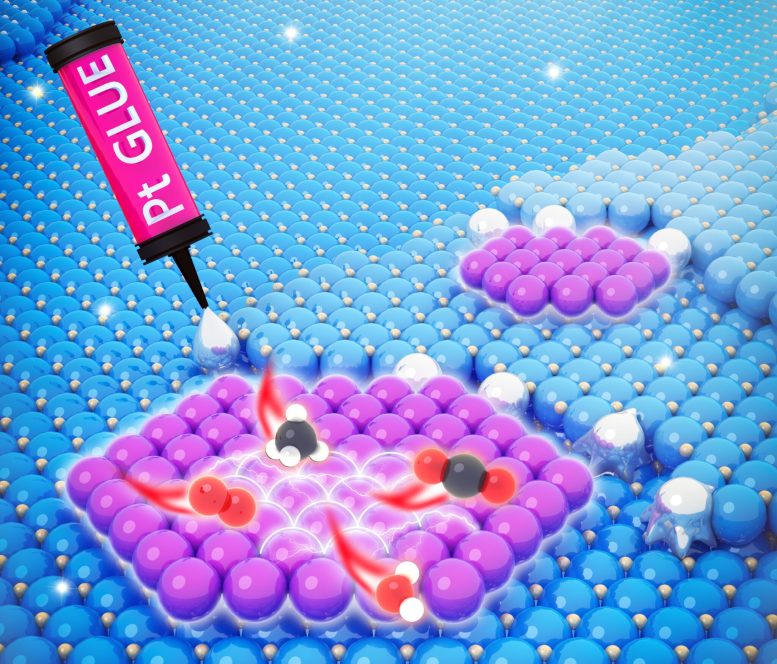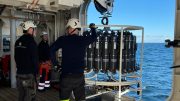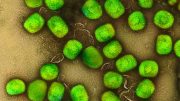
Researchers have developed palladium oxide catalyst “rafts” connected by single platinum atoms. This catalyst improves the cleaning of natural gas, enhances tolerance to water vapor, and reduces the release of unburned methane.
Palladium oxide catalyst cleans up emissions and enhances water vapor tolerance.
A newly developed catalyst with unique, atomic-sized “rafts” does a better job than current technology for cleaning up emissions from natural gas engines.
Natural gas-powered technology might become cleaner and more practical for trucks, off-road vehicles, and equipment powertrains as a result of the research, which was published in Nature Catalysis. Researchers created palladium (Pd) oxide catalyst “rafts” that are bound together by single platinum atoms. Their catalyst cleans up natural gas and makes the catalytic process more tolerant of water vapor, lowering the quantity of unburned methane released.
While natural gas engines produce roughly 25% less carbon dioxide and particle pollution than gasoline or diesel engines, they still emit unburned methane because their exhaust emission catalytic converters are inefficient at low temperatures. The new technology was shown to operate at higher reaction rates than existing technologies.
“The improvements in energy efficiency have to go hand in hand with the after-treatment technologies,” said Yong Wang, Voiland Distinguished Professor at Washington State University’s Gene and Linda Voiland School of Chemical Engineering and Bioengineering. He is also one of the paper’s corresponding authors. “Currently, combustion from methane to generate power is not able to use the most efficient combustion technology. So it works, but there is room for further improvement in that efficiency.”
Researchers from WSU and the University of New Mexico headed the team, which included partners from the United States, the European Union, and China.

Catalyst “rafts” of palladium (Pd) oxide that are held together with single atoms of platinum are effective at cleaning up emissions from natural gas engines. Credit: Cortland Johnson, PNNL
While not as widely used in the U.S., natural gas engines are commonly used in vehicles worldwide, especially in China, Iran, and India. Because they’re less polluting than diesel engines, they are often used in trucks and buses in urban areas. Natural gas-powered engines are also used in the gas industry to run thousands of compressors that pump natural gas to people’s homes.
However, these natural gas-powered vehicles emit unburnt methane because their exhaust emission catalytic converters are not efficient at low temperatures. The more efficiently the engines work and the cleaner they burn, the lower the exhaust temperature becomes and the poorer the catalysts perform at cleaning up pollutants. Unburnt methane from the engine, in particular, is a potent greenhouse gas that is about 25 times worse than carbon dioxide, contributing to climate change.
Furthermore, one of the byproducts of methane combustion is water, and conventional catalysts are “notoriously bad” when it comes to working in the presence of water, said Wang. The cleaner-burning fuel ends up working against itself in removing pollutants.
Compared to typically used catalysts made of Pd oxide nanoparticles, the rafts the researchers developed provide better tolerance to water vapor with improved reactivity.
“The strongly bound platinum (Pt) can serve as a nucleation site for added metal atoms,” said Abhaya K. Datye, professor in UNM’s Department of Chemical and Biological Engineering and one of the corresponding authors of this study. “Using trapped Pt atoms, we were able to demonstrate the formation of Pt as well as Pd oxide two-dimensional rafts which modify the oxidation state and reactivity of the active phase.”
“Our theory calculations suggested that the raft does not readily dissociate water, thus inhibiting the adverse effect of water poisoning in the catalysis of methane oxidation,” said Hua Guo, professor in UNM Department of Chemistry and Chemical Biology.
The researchers are now working to further advance the catalyst technology and are hoping to eventually work with industry to commercialize it.
Reference: “Engineering catalyst supports to stabilize PdOx two-dimensional rafts for water-tolerant methane oxidation” by Haifeng Xiong, Deepak Kunwar, Dong Jiang, Carlos E. García-Vargas, Hengyu Li, Congcong Du, Griffin Canning, Xavier Isidro Pereira-Hernandez, Qiang Wan, Sen Lin, Stephen C. Purdy, Jeffrey T. Miller, Kevin Leung, Stanley S. Chou, Hidde H. Brongersma, Rik ter Veen, Jianyu Huang, Hua Guo, Yong Wang, and Abhaya K. Datye, 18 October 2021, Nature Catalysis.
DOI: 10.1038/s41929-021-00680-4
The work was partially funded by the U.S. Department of Energy Office of Science, Catalysis Science Program, the U.S. Department of Energy Office of Energy Efficiency and Renewable Energy/Vehicle Technologies Office, the Advanced Manufacturing Office, the U.S. Air Force Office of Scientific Research, Chinese National Natural Science Foundation, and the NSF Engineering Research Center CISTAR.









Be the first to comment on "New Catalyst Could Clean Natural Gas Engine Emissions"